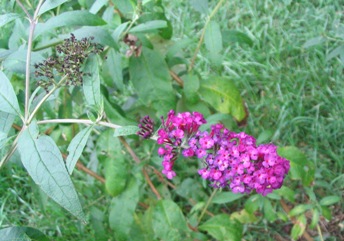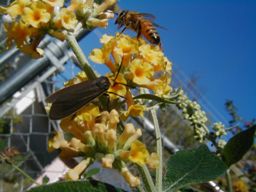Summer is finally here! One of the many plants that bloom now is the Butterfly bush, an ornamental introduction originally from southwestern China. This plant has been a favorite of gardeners and butterfly lovers.
Appearance
Butterfly bush, Buddleia (or Buddleja) davidii, is a fast growing shrub reaching up to 6-10 feet tall and 4-10 feet wide. Dwarf and semi-dwarf varieties that are much smaller are available. The butterfly bush has opposite leaves that are oblong or lanceolate in shape.
It typically blooms from June to October, and is available with blooms that are white, purple, blue, pink, and yellow. The flowers are held in a long panicle at the end of the stalks and are a great attractant to butterflies and even bees for pollination. The flowers resemble a lilac flower, which leads these plants to be called 'summer lilac' in some locations.
Common Cultivars
There are many different varieties of Butterfly bush to choose from. 'Black Knight' is a very common variety that is fragrant with dark purple to black flowers. 'Pink Delight' has large pink blooms, as the name implies. For a smaller choice, Buddleia x Nanhoensis 'Nanho Blue' or 'Nanho Purple' is a dwarf variety. These are just a few of the many varieties to try for different colors and sizes in your landscape.
Growth & Care
Butterfly bush is quite easy to care for and can handle the heat common to Nebraska in summer. Butterfly bush is a plant known as a suffrutescent plant, meaning that it isn't quite a woody shrub but it is more than a perennial plant.
This plant grows quickly and dies back close to the ground every year. Wait until new growth begins to determine how far back to cut it each year, removing the dead growth.
Butterfly bush should be planted in full sun, and old flowers should be removed (deadheaded) to encourage reblooming.
The Darker Side of Butterfly Bush
Although Butterfly bush is a beautiful plant some states, including Pennsylvania, New Jersey, Kentucky, Virginia, and Delaware, have begun to list it as potentially invasive. It has escaped cultivation in scattered locations in the Northeast, Southeast and Mid-
Atlantic regions, and in the western U.S. from southern California to northern Washington state.
A 50-year study published in March 2008, showed Buddleia grew more vigorously in it's introduced range, compared to its native range. The Invasive Shrub Buddleja daviddi Performs Better in Its Introduced Range, Ebeling, S. et al.
The Invasive Plant Atlas of the United States states butterfly bush readily invades disturbed sites and riparian areas. The seeds are dust-like particles which can easily be distributed by wind. And although adult butterflies will use the plant as a nectar source their larve cannot survive on it.
Butterflybush, Invasive Plant Atlas of the United States


